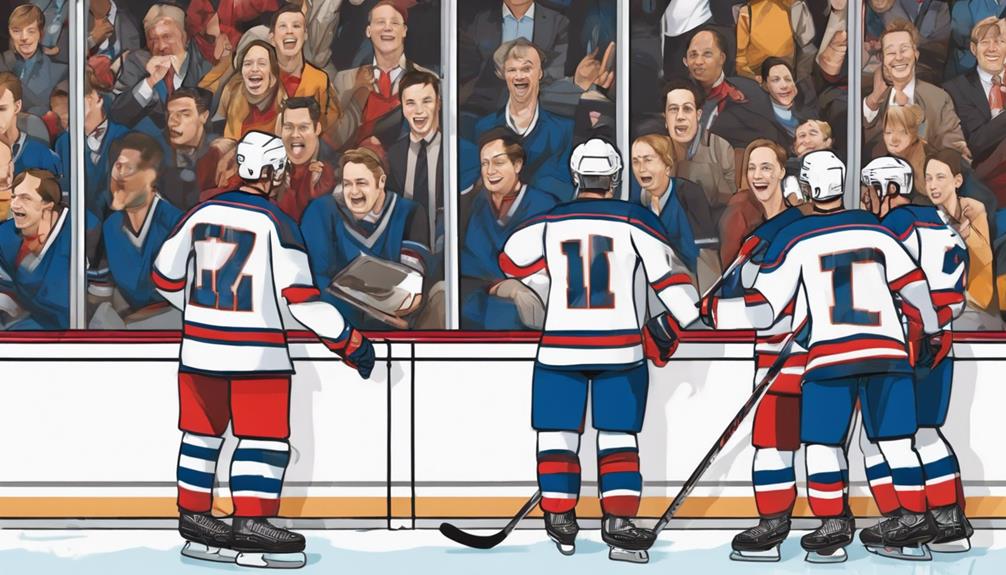Understanding when to change lines in hockey is a nuanced art form that blends player intuition with strategic decision-making. From the subtle cues of line chemistry to the ebb and flow of game dynamics, players must navigate a complex web of factors to make split-second choices that can tip the scales in their team's favor.
How do these athletes seamlessly transition on and off the ice, ensuring optimal performance and maintaining a competitive edge? The answer lies in a delicate dance of communication, observation, and timing that separates good players from great ones.
Importance of Line Chemistry
Effective team performance in hockey heavily relies on the chemistry developed between players on the same line. Line communication is crucial for seamless coordination during gameplay. Players must communicate effectively to anticipate each other's moves, adjust positioning, and execute plays efficiently. This communication allows for quick decision-making and adaptability to dynamic game situations.
Player rotation within a line is another key aspect that influences chemistry. Understanding each player's strengths and tendencies enables effective rotation, maximizing the line's overall performance. Consistent player rotations can prevent fatigue, maintain intensity, and exploit strategic opportunities.
Developing strong line chemistry through communication and rotation enhances team cohesion, leading to improved on-ice performance and increased chances of success.
Reading Game Flow
Analyzing the flow of the game is a critical skill for hockey players to make informed decisions and adapt their gameplay accordingly. To excel in reading game flow, players must focus on:
- Game awareness and player communication: Understanding the game's tempo and communicating effectively with teammates to adjust strategies.
- Quick decision making: Rapidly assessing the evolving dynamics on the ice to respond promptly to changing situations.
- Situational awareness: Recognizing critical moments in the game that require specific actions or adjustments.
- Anticipating opponent moves: Predicting the opposition's strategies based on cues from the game flow to stay one step ahead.
Mastery of these elements enhances a player's ability to contribute effectively to the team's success.
Listening to Bench Instructions
Incorporating bench instructions into their on-ice decision-making process is a crucial aspect of a hockey player's strategic awareness and adaptability during gameplay. Effective bench communication ensures players are aware of quick substitutions needed to maintain line cohesion. This communication is vital for seamless transitions that keep players fresh and maintain the team's performance level.
Players must be attentive to the instructions provided by coaches or teammates on the bench to make timely changes that can shift the momentum of the game in their favor. Player awareness of the game situation, coupled with prompt responses to bench directives, plays a significant role in optimizing team performance and adapting to the ever-changing dynamics of a hockey match.
Recognizing Fatigue Signals
Amid the fast-paced nature of hockey gameplay, astute players must keenly observe and interpret subtle cues indicating physical fatigue to make informed decisions on line changes. Effective recognition of fatigue signals is crucial for optimal energy management and player performance.
Key aspects to consider include:
- Body Language: Monitoring for signs of slumped posture, slower movements, or labored breathing.
- Decreased Intensity: Noticing a drop in player speed or reduced engagement in plays.
- Communication: Encouraging open dialogue between teammates to gauge energy levels.
- Utilizing Recovery Strategies: Implementing quick recovery techniques during gameplay to maintain player stamina.
Strategic Timing for Line Changes
Strategically timing line changes in hockey games plays a pivotal role in maximizing player performance and maintaining a competitive edge throughout the match. Coaches closely monitor line matchups, analyzing their team's composition against the opponents to exploit favorable situations. Quick shifts are strategically executed to capitalize on mismatches or exploit tired opponents.
By making timely line changes, teams can ensure that players are fresh and at their peak when facing critical game moments. Moreover, understanding the flow of the game and recognizing when to implement quick shifts can disrupt the opponent's rhythm and create scoring opportunities.
Frequently Asked Questions
How Do Players Determine Who Goes on the Ice First During a Line Change?
During line changes, players determine who goes on the ice first based on predetermined line dynamics and communication techniques. Bench strategy and team coordination play essential roles in ensuring smooth transitions and maximizing player effectiveness.
Are There Specific Hand Signals or Gestures Used to Communicate Line Changes on the Bench?
Within the intricate web of bench dynamics and teamwork, hand signals serve as a silent language of communication among hockey players. These gestures, honed through strategic planning, allow seamless line changes, ensuring optimal performance.
What Factors Contribute to a Player's Decision to Stay on the Ice for an Extended Shift?
In hockey, a player's decision to stay on the ice for an extended shift is influenced by fatigue management, player communication, coaches' instructions, and the current game situation. Balancing these factors is crucial for optimal performance.
How Do Players Ensure They Are in the Correct Position for Their Line When Changing During Gameplay?
Position coordination and timing accuracy are critical for players to seamlessly change lines during gameplay. Understanding their role and communicating effectively with teammates ensures smooth transitions, maximizing team efficiency and maintaining strategic advantage on the ice.
What Is the Protocol for Players Who Miss Their Line Change Window Due to Being Caught up in a Play?
Line change strategies in hockey involve precise timing and communication to ensure smooth transitions. When players miss their change window due to on-ice engagement, they must quickly communicate with teammates to rectify the situation and maintain strategic positioning.









